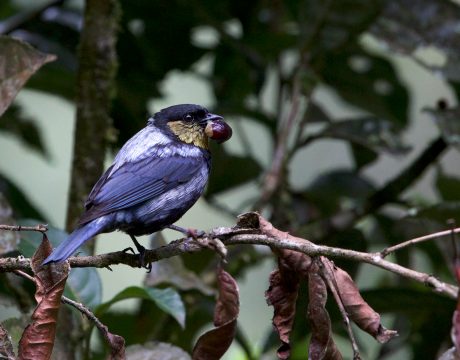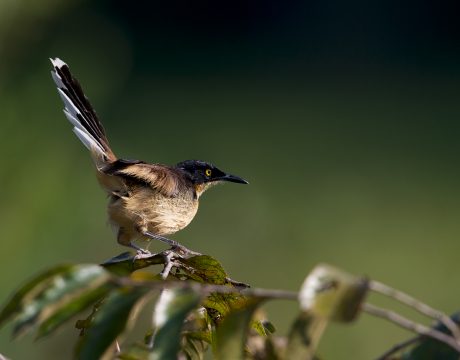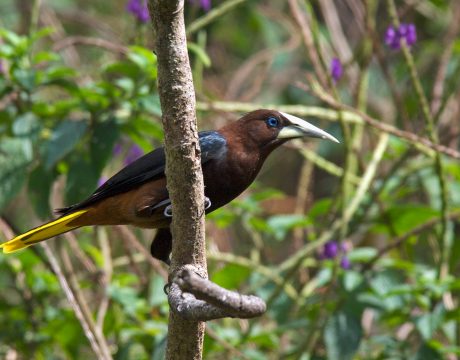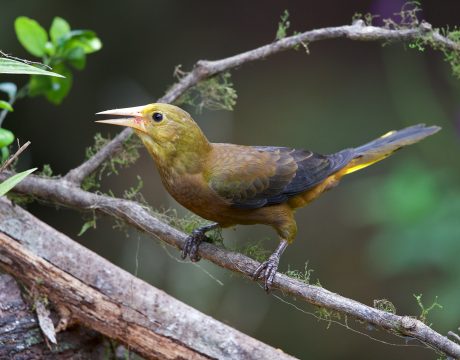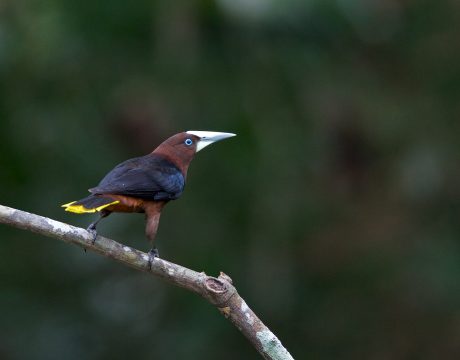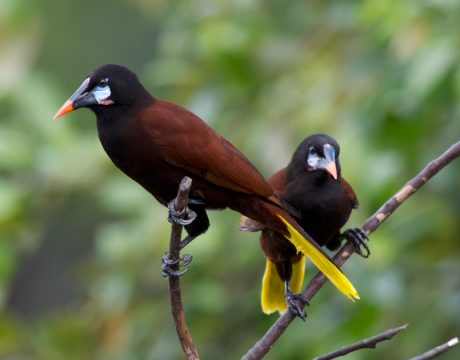Return of Bird of the Week: Crimson-backed Tanager
Not all of the tanagers are yellow and blue. This is the Crimson-backed Tanager, a species native to northwestern South America and Panama. It’s sexually dichromatic; the males have a slightly swollen, white lower mandible, shown here. While the species is not well studied, it appears to adapt reasonably well to human alteration of the tropical landscape. It’s common in cities and disturbed areas. It was the first bird WC and Mrs. WC saw from their hotel window a quarter mile from the Panama City airport. Based on Breeding Bird Survey, the population is stable, even if the population size…
Return of Bird of the Week: Silvery-backed Tanager
Another spectacular tanager, the Silver-backed Tanager, feeding on a berry on the grounds of the hotel where were staying. It’s also called a Silvery Tanager, but that seems less descriptive to WC. Officially it’s Tangara viridicollis, the same genus as last week’s Saffron-crowned Tanager. But that’s no particular distinction, there are fifty-some species in the genus Tangara, most of them ridiculously spectacularly colorful. But unlike most Tangara species, the Silver-backed Tanager is strongly dichromatic. The female is very different. (No, it’s not a very good photo; an extremely uncooperative subject. But good enough to illustrate the point.) Silvery-backed Tanagers are omnivorous, eating fruits, nuts…
Return of Bird of the Week: Saffron-crowned Tanager
We’re looking at Tanagers for the next few weeks. Today, please meet the Saffron-crowned Tanager. It’s pure flash. This species occurs through the Andes from Venezuela south to Bolivia, and occupies humid montane forests and secondary woodlands. Due to human destruction of habitat, ornithologists are concerned that the population numbers may be decreasing; however an accurate estimate of the population size is unavailable. If you’ve been to Machu Pichu, you know just how rugged and difficult this species’ native terrain is, and why so little is know about it. Saffron-crowned Tanagerhas a bluish green body with black chin and eye…
Return of Bird of the Week: Golden-hooded Tanager
It’s been more than a year since WC blogged about Tanagers, the most colorful bird family in the Neotropics. WC will attempt to make up for the lapse by focusing on Thraupidae, the tanager family, for the next few weeks on the birds of the week. There are an astonishing 380 or so species in the family Thraupidae. WC has photos of about 100 of them, although not all are even close to presentation quality. So we could have nothing but tanagers for quite a while. We’ll see. We’ll start with one of the colorful species, the Golden-hooded Tanager. In…
Return of Bird of the Week: Black-capped Donacobius
The last few weeks we’ve been looking at Oropendolas, members of the Icterid family of birds, a family with dozens of members. Today we visit a monotypic family of birds, whose single member is the Black-capped Donacobius. In WC’s lifetime, this species has been considered a Mimid, like a thrasher or a mocking birds, a wren, and now a monotypic. And there are suggestions it may be a member of an Old Word family of warblers. So much for certainty. It’s a handsome bird, mates for life and is almost always seen in pairs. It’s a cooperative breeder; the kids…
Return of Bird of the Week: Crested Oropendola
While there are nine or ten recognized species of oropendolas,[^1] WC has only managed photos of five of them. The fifth and last WC has documented is the Crested Oropendola. WC wouldn’t usually use a feeder shot like this, but it’s the only image WC has that actually shows the “crest” that gives the species its common name. Most of the time, the signature “crest” is laid down against the top of the head. This is probably the most common and widespread of the oropendolas, ranging from Panama south to northern Argentina. It’s also probably the oropendola with the broadest…
Return of Bird of the Week: Russet-backed Oropendola
Another Oropendola species, this one a South American species near the southern margin of it range in central Peru. The Russet-backed is about the same size as its Crested cousin. The taxonomy of Oropendolas in general and Russet-backed in particular is undecided. There are presently six subspecies, but two of those subspecies – the Yellow-billed and the Black-billed Oropendola – have been proposed as separate species. This is probably the Alfredisubspecies, the proposed “Yellow-billed” Oropendola. Like its cousins, this is a colonial nester, with long, pendulous nests. The IUCN reportsthis is a species of least concern because of its comparatively wide…
Return of Bird of the Week: Chestnut-headed Oropendola
Here’s another Oropendola, this time a Chestnut-headed Oropendola. This is one of the smaller members of the genus, with a body length of about 14 inches (11 inches in the female). It’s fairly widely distributed, from the Caribbean coast of Mexico through Central America as far south as northern Ecuador. Like its fellow Oropendolas, it is a colonial nester, with long, pendulous nests on a tree at a forest edge. Unlike most of its fellow congeners, a typical colony may have a dozen or so female and just 3-4 males, a polygynous mating structure. Chestnut-headed Oropendolas are poorly studied; ornithology…
Return of Bird of the Week: Montezuma’s Oropendola
The largest of the four Central American oropendolas, the Montezuma’s Oropendola absolutely lives up to its big name. This is the big cousin of North America’s Red-winged Blackbird, is the largest member of the Icterid family of birds. Not only is its coloration spectacular; it’s a colonial nester and a dawn chorus of Montezuma Oropendolas will knock you right out of your bed. Together with Howler Monkeys, their calls are one of the signature sounds of the jungles of Middle America. Its name in both English and Spanish give tribute to the last Aztec emperor, Moctezuma II. The word “oropendola”…
Return of Bird of the Week: Black Oropendola
Last week’s Brewer’s Blackbirdis a member of the family Icteridae. A more exotic member of that family is the Black Oropendola. This species has a fairly narrow range: northern Columbia and far eastern Panama. Like all of the oropendolas, it’s a weaver, building long, pendulous nests that hang is groups from a tree in the open, often in a meadow or at the edge of a field. This is a female working on a new nest. But what sets the Black Oropendola apart from its fellow species is the amazing facial coloration. The red and blue patches make this one…






